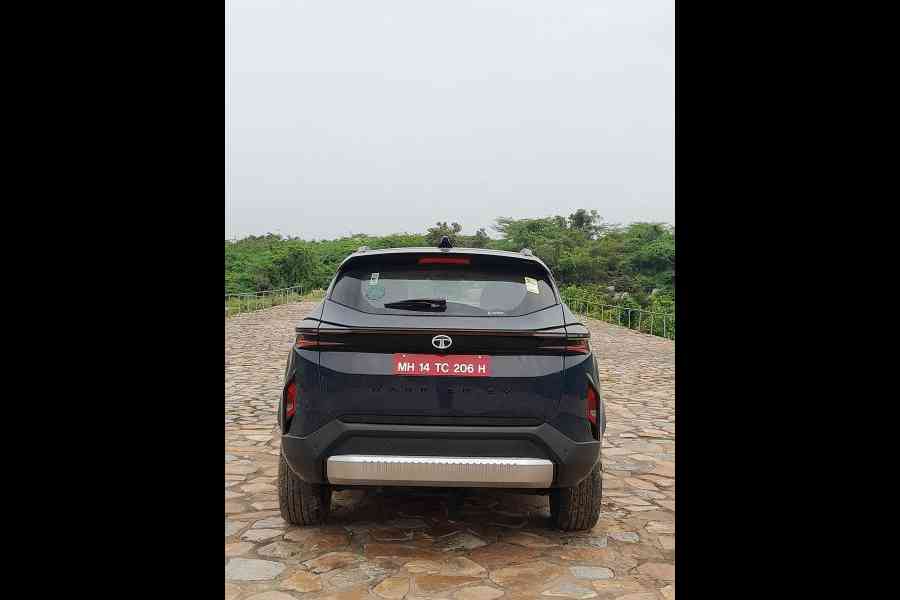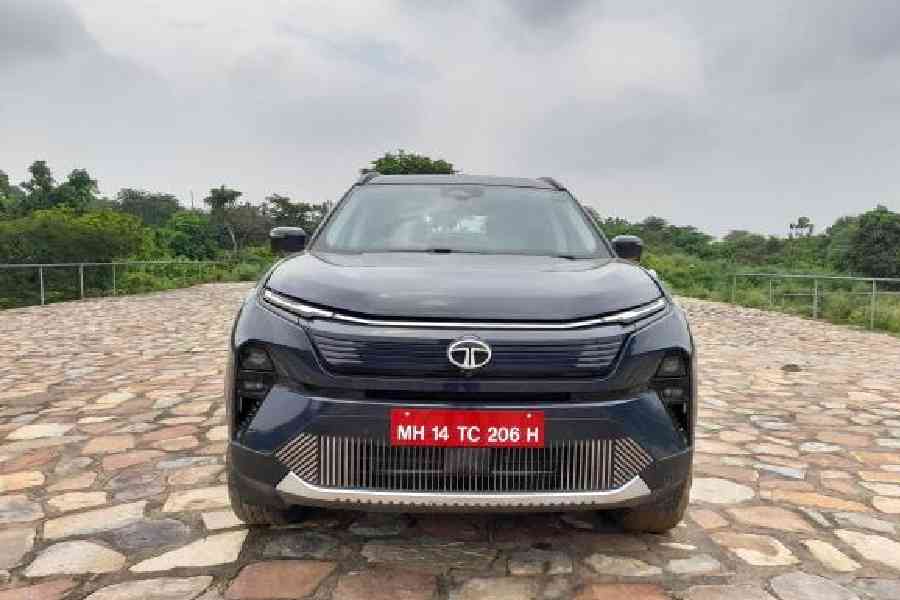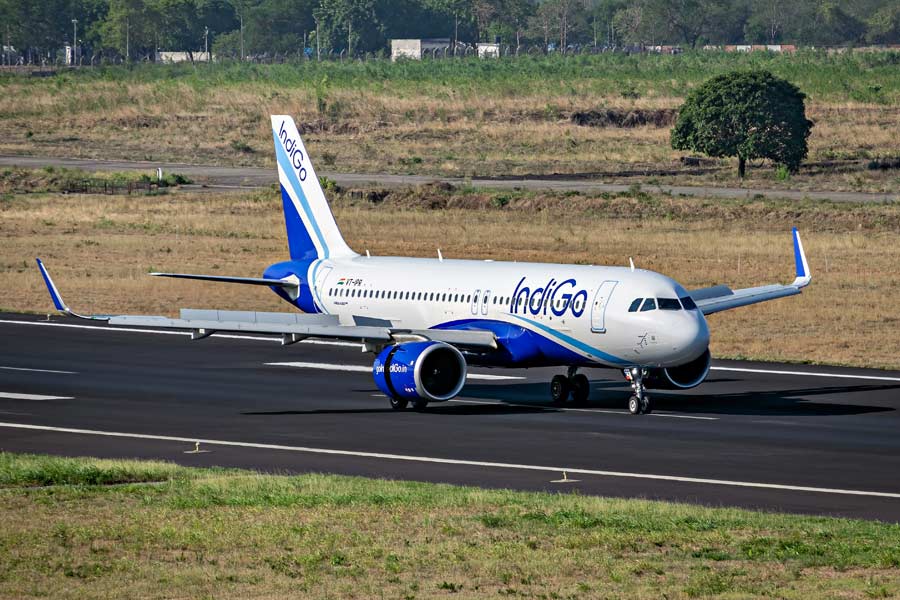The Tata Harrier.ev is Tata Motors’s Tata Passenger Electric Mobility’s (TPEM) answer to all the electric SUVs in the ₹20 lakh to ₹30 lakh price segment. We got a demonstration of its off-roading, driver assistance systems and speed capabilities under controlled conditions about a month ago (see Tough Contender, June 15 edition). Finally, we got a taste of it in real world conditions recently when TPEM invited us to a drive in Delhi.
Between the two events, a few things happened. As we had mentioned earlier, there are two battery pack options for the Harrier.ev, a 65kWh and a 75kWh. Then there are the rear wheel drive (RWD) and the Quad wheel drive (4x4) versions. So, prices of the five RWD versions have been set between ₹21.49 lakh for the entry level Adventure 65 trim to ₹27.49 lakh for the top Empowered 75 trim. The Quad wheel drive is available only in the Empowered 75 version and has been priced at ₹28.99 lakh. All these are all-India prices at the showroom before taxes and levies. They also do not include the price of the charger and installation cost. A 7.2kW AC fast charger option is available for an additional ₹49,000.
Also, TPEM is now giving a ‘Lifetime HV Battery Warranty’ for all versions of the Harrier.ev and the 45kWh versions of the Curvv.ev and Nexon.ev that are registered in the names of private individuals or in the names of companies as perks for private individuals. ‘Lifetime’ means a period of 15 years from the first date of registration of the vehicle and will not depend on how many times ownership changes as long as the owners keep TPEM informed about the transfer of ownership to their names. This, more than anything else, will help create value visibility in used EV market since later owners, too, will have the assurance of a warranty on the battery.
Coming back to the SUV itself, the version we drove was the top-of-the-line Quad wheel drive Empowered 75 in a rather nice blue that TPEM calls Nainital Nocturne. Here are our impressions.
ON THE OUTSIDE
In terms of looks, there is a certain familiarity with the design of the Harrier.ev that carries over from the diesel versions. The biggest difference is at the front end. This EV gets the same slatted look in the lower part of the front bumper as the Curvv.ev and the Nexon.ev, signifying that it is an EV. The grille is blanked out but the part there gets a horzontal pattern unlike the shiny black of TPEM’s other EVs. Also, the scuff plate is finished in matte silver for this model. The rest of the front end looks similar.
On the flank, one will notice a ‘.ev’ badge and alloys that are designed to reduce drag. Also, the Harrier.ev that we drove came shod with 245/55 19-inch Goodyear Electric Drive tyres that are intended to reduce rolling resistance. These sit nicely in the wheel wells and give the EV a confident stance.

Apart from the absence of a tailpipe and scuffplate finished differently, it the Harrier.ev looks almost like its ICE sibling
The tail end is much the same as the ICE vehicle with changes in the finish of the scuff plate matching those up front. Also, the tailpipe is missing.
This is an EV that visually does not shout that out with design features that typically electrics tend to have.
ON THE INSIDE
Again, things look familiar here. The floor, of course, is higher than that of the ICE version as the battery has gone under it, but that doesn’t squeeze the headroom all that much. There’s enough and more for average to somewhat taller-than-average individuals. Speaking of which, the cooled seats are comfortable and supportive. The driver’s seat comes with electrical adjustments for position and has three memory settings too.
The familiar dashboard design now has a patterned white insert that we aren’t great fans of but which isn’t all that obtrusive either. But we like the rest of it, particularly the fact that there is a whole bunch of controls that can be accessed directly albeit through backlit touch points on the centre console. No fiddling around for them on the touchscreen when driving. This is a more sensible way of doing things in our books rather than stuffing everything into touchscreens and cleaning up the dashboard to minimalistic sparseness.
There are touches in the interior that one would expect in vehicle in this segment, like the buttons on the front passenger seat that can be operated from the rear seat to create more room for the rear passenger. The sunroof is large and creates a very airy cabin. Then there is a whole bunch of USB and other ports throughout the vehicle, including a wireless charger. Storage spaces for small items and cups and bottles abound. The glove box is cooled.
What might be bit of an issue though is the luggage space with the parcel shelf in place. Compared with the ICE version, part of it has been taken up by the battery and if doing longer trips, to fit more luggage, one might need to either leave the parcel shelf at home, or use a roof rack, or both. And longer trips are possible in this EV, particularly in the 75kWh version that we were driving, provided one knows where to recharge at the destination.
This version also comes equipped with front and rear dashcams that can record for about four hours but one can increase the time by using a bigger memory card. It is also compatible with Tata’s remote IRA app and with it one can lock the vehicle, honk, turn on approach lights, hazard lights, position lights and air conditioner. It also gives information on state of charge and range, vehicle health and so on. Quite useful as long as you keep your phone safe.
ON THE ROAD
The earlier specialised tests (that we experienced in the Harrier.ev indicated its credentials under various driving conditions (see Tough Contender, June 15). And while we found the vehicle to be capable, we did not get a feel of what it would be like to live with in the real world. So, we drove out of Surajkund, where we were staying, onto the Faridabad-Gurgaon road in the morning.
And, as expected, very soon we were in morning rush hour traffic. This is the kind of traffic condition that the Harrier.ev will face most of its life. It has four driving modes — Eco, City, Sport and Boost. They work through different drivetrain mappings. Most of the time City mode does a good enough job. We thought Eco made things a bit sluggish, Sport livens things up. All this while power output available is 200kW (268hp and 470Nm).
Boost is the liveliest of the lot. In this mode, the maximum power available is 260kW (349hp and 504Nm) and, to be honest, once in this mode, one doesn’t really want to get out of it. The drive goes to another level of effortlessness. That said, when out of the Boost mode, the torque still remains quite close to the peak and, therefore, the vehicle doesn’t feel lethargic.
We did a little experiment with the settings to see what it could do with the range. With 76 per cent of charge left in the battery and the EV static, we switched through Eco, City, Sport and Boost modes. The range the vehicle showed us was 363km, 346km, 328km and 311km, respectively.
While the Harrier was easy to drive and place on the road, what with its 540° camera helping to place it exactly in tight spaces, we did find the absence of the Auto Hold feature a miss that forces the driver to keep the brake pressed at traffic lights or long stops, or shift to Neutral. This was even more evident when driving in stop-go traffic, where electrics typically score high in keeping the stress of driving down.
We also passed through some soft earth and muddy bits and tried out the Mud & Slush and other modes. The passage was without incident. But one needs to be careful as the ground clearance isn’t as much as it’s for hardcore off-roaders although many of the capabilities are.
THE CALL
As we mentioned earlier, we drove the Quad wheel drive Empowered 75 version of the Tata Harrier.ev that retails for ₹28.99 lakh. At that price we think it is an attractive deal with good on-road and off-road capabilities, comfort, performance, safety features and, now, the battery warranty thrown in. So this one clearly is a go.











